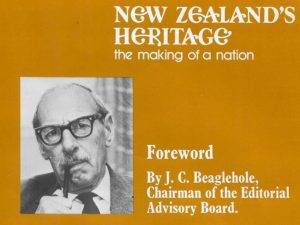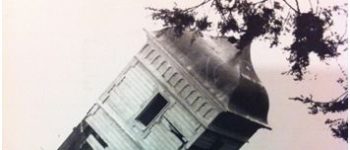1969: Nelson Provincial Council Buildings Demolished
April 30, 2021
By AHNZ
Today in New Zealand history, 30 April, 1861, the Nelson Provincial Council opened its new buildings and sat at their first council meeting therein. Superintendent John Perry Robinson¹ had laid the foundation stone on 26 August 1859 with the inscription “Let Justice be done to all though the heavens fall.” Unfortunately, only 14 years later, the Abolition of the Provinces nationalised the buildings and passed them into the control of Central Government in Wellington. Of course, central government did not care for Nelson’s confiscated treasurers the way a local would so had the building torn down from 12 September 1969².
“When the Justice Departement shifted equipment and records from the old offices in the Provincial Council building earlier this month, the last chapter in the usefulness of this beautiful old building was written. One hundred and seven years ago this month the foundation stone of the building to house the provincial government was laid, and the building was opened on April 30, 1861. In more recent years it has housed various Government departments, but all have now left and are accomodated in the new, bud comparitively, characterless building adjacent to it. The old chambers have a dim future. They are in a bad state of disrepair and notwithstanding pleas to have them retained as an historica monument, it seems certain that they will be demolised to permit the completion of the proejcted Government block.” – An Era Passes, Nelson Photo News, August 20, 1966; Photonews.org.nz
Viewing New Zealand history an an Anarchist is to constantly observe the theme of less Localism and and more centralism over time in every sphere of life. Governance, media, religion, sport, transport, commerce, language, history, music, culture,..Kiwis give it away a little at a time, year after year. Wellington politicians, of course, facilitate this while pretending to us otherwise. The principle of Subsidiarity has never been consciously appreciated by New Zealanders, we solve our Big Brother problems by looking for a Bigger Brother.
“Subsidiarity is a principle of social organization that holds that social and political issues should be dealt with at the most immediate (or local) level that is consistent with their resolution.”- Wiki
“Decentralization has, not only an administrative value, but also a civic dimension, since it increases the opportunities for citizens to take interest in public affairs; it makes them get accustomed to using freedom. And from the accumulation of these local, active, persnickety freedoms, is born the most efficient counterweight against the claims of the central government, even if it were supported by an impersonal, collective will.” – Alexis de Tocqueville (1835), ibid
“If you strike me down, I shall become more powerful than you can possibly imagine.” -Obi-Wan Kenobi
Why did the Nelsonians allow Keith Holyoake’s National 2.0 Government trash their treasure? There was a majority opinion among Nelsonians that the buildings should be preserved for future generations, Mayor Trevor Horn stating “once this goes part of Nelson goes too.”³
 Late New Zealand’s 1960s mainstream was not a civic-minded population. The Baby Boomers had come of age. Celebrity Queen and Prince were out, the Swinging Sixties were in. Idealism, abandon, disconnection from the past. As Tom Wolfe observed in The Great Relearning⁴, this generation went so far as to abandon laws of hygiene such as non-shared tooth brushes, beds, use of linen, washing. This led to “diseases no living doctor had ever encountered before, diseases that had disappeared so long ago they had never even picked up Latin names,” wrote Wolfe. If the young Boomer idealistically eschewed basic facts just because he didn’t think them up himself why would an 1860s building matter? It didn’t.
Late New Zealand’s 1960s mainstream was not a civic-minded population. The Baby Boomers had come of age. Celebrity Queen and Prince were out, the Swinging Sixties were in. Idealism, abandon, disconnection from the past. As Tom Wolfe observed in The Great Relearning⁴, this generation went so far as to abandon laws of hygiene such as non-shared tooth brushes, beds, use of linen, washing. This led to “diseases no living doctor had ever encountered before, diseases that had disappeared so long ago they had never even picked up Latin names,” wrote Wolfe. If the young Boomer idealistically eschewed basic facts just because he didn’t think them up himself why would an 1860s building matter? It didn’t.
 Next, something different, something, nobody counted on occurred: Equal and opposite reaction. The turn of the decade into the 1970s vitalised mainstream New Zealand into treasuring its heritage like never before. In striking down the Nelson Provincial Buildings and all they stood for the people of the sixties had made them more powerful than they could possibly imagine; They became a symbol.
Next, something different, something, nobody counted on occurred: Equal and opposite reaction. The turn of the decade into the 1970s vitalised mainstream New Zealand into treasuring its heritage like never before. In striking down the Nelson Provincial Buildings and all they stood for the people of the sixties had made them more powerful than they could possibly imagine; They became a symbol.
History and heritage was so important to New Zealanders in these early 1970s that even Milo used ‘Highlights of New Zealand History‘ branding to sell their product. These were also the years that so many regional historic societies flourished (perhaps even formed) and federated. I’m always impressed when visiting historical monuments at how very many of them were created or refurbished during this great zenith. Likewise, more public parks and institutions and facilities were created by groups like Lions, Rotary, and Jaycees than you could ever count and they too were especially active during this time period. A civic-abdication turned into a civic boom!
“The instigators of this civic pride and heritage spirit was not being generated by the new generation coming of age at this time, the Boomers. Quite the opposite! The Baby Boomers delighted in the great civic wave crashing. They despised the Establishment, rebelled against it rather than joining..”- 1971: New Zealand’s Heritage: The Making of a Nation; AHNZ
The NPC building itself is gone, only fragments remain, but my argument is that this loss and others like it primed the pump for New Zealanders to care about their history again. For a time, they did. In replacing the Nelson Provincial Building with Brutalism and then tearing it down the sixties Kiwis awoke civic pride. It’s bitter sweet to observe than in 1969, as also in the 2020s, this country needs more than a building right now. It needs hope⁵ .
—
1 J P Robinson was drowned while in office on 28 January, 1865. As Superintendent of Nelson he had completed a visit to Greymouth and now tried to make another stop, going ashore in a boat at the Buller River to stay a while and explore. The boat hit the bar, killing 3 crewman along with the Super himself. His body was never found.
2 Ref. Nelson Provincial Buildings, The Prow
3 The Nelson Mail, Ref. ibid
4 Ref. 1971: BLERTA
5 Quote, V for Vendetta (2005)
Image ref. Demolition time; Nelson Provincial Buildings, The Prow
Image ref. Model of the NPC buildings at Nelson Provincial Museum; AHNZ Archives (2019)
 Like Comment Share
Like Comment Share







